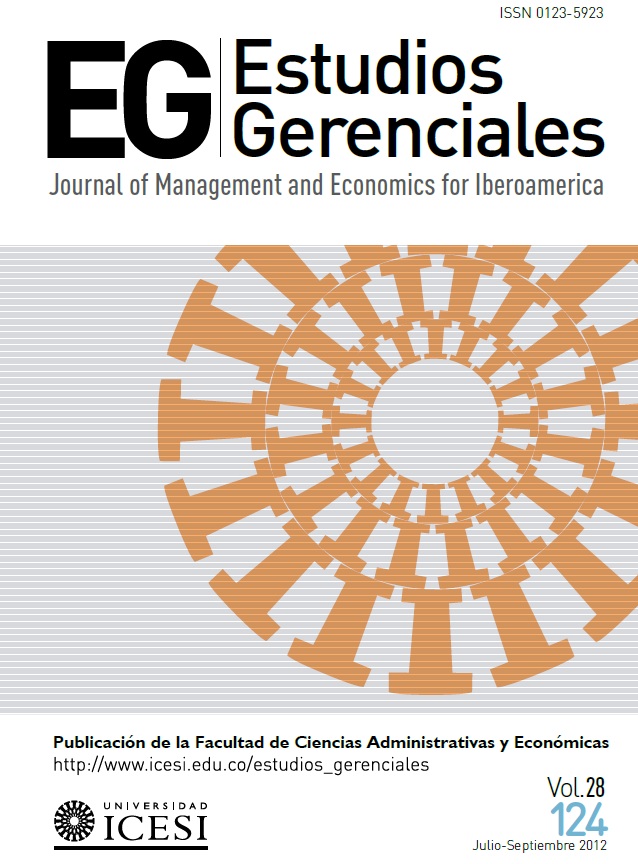A snapshot of training practices in Peru
DOI:
https://doi.org/10.1016/S0123-5923(12)70216-4Palabras clave:
Training, need assessment, human resource managementResumen
Organizations need well trained employees in order to maintain a competitive advantage. The purpose of this paper is to describe current training practices in Peru and to provide recommendations for improving organizational performance. This paper also aims to set priorities for future research work. Human capital theory and contributions on need assessment, and training planning, implementation and evaluation served as theoretical framework. This is a cross-sectional, exploratory study that used information from surveys conducted in 24 Peruvian companies. The findings reveal a strong interest in training, particularly with regard to the improvement of competencies, preference for face-to-face training, and the use of reaction evaluation methods. The recommendations include, among others, improving the provisions for internal support, policies, technology, behavioral evaluation, and resources.Descargas
Referencias
American Society for Training and Development (2011). State of the industry report. Available at: http://store.astd.org/Default.aspx?tabid=167ProductId=22697.
Anderson, J. (2000). Training needs assessment, evaluation, success, and organizational strategy and effectiveness. An exploration of the relationships. Disertación doctoral no publicada. Logan, UT: Utah State University.
Becker, G. (1962). Investment in human capital: A theoretical analysis. Journal of Political Economy, 70(5), 9–49.
Becker, G. (1964). Human capital. New York, USA: Columbia University Place.
Becker, G. (1993). Human capital: A theoretical and empirical analysis with special reference to education (3rd ed.). Chicago, IL: University of Chicago Press.
Blunch, H. & Castro, P. (2007). Enterpriselevel training in developing countries: do international standards matter? International Journal of Training & Development, 11(4), 314–324.
De Geus, A. (1997). The living company. Boston, MA: Harvard University Press.
Desimmone, R. and Harris, D. (1998). Human Resource Development. Orlando: Dryden Press.
Gilley, J., Eggland, S. & Maycunich, A. (2002). Principles of human resource development (2nd ed). Cambridge, MA: Perseus.
Goldstein, I. (1986). Training in organizations: needs, assessment, development and evaluation. Monterey: Brooks/Cole.
Harris, D. and Desimmone, R. (1994). Human Resource Development. Fortworth: Dryden Press.
Herbert, G. and Doverspike, D. (1990). Performance appraisal in the training needs analysis process: a review and critique. Public Personnel Management, 19(3), 253–271.
Jimenez, S., Sanchez, R. y Sanchez, G. (2010). Los institutos de administración pública en España: programas de formación para el personal al servicio de la administración. Estudios Gerenciales, 26(116), 169–192.
Kirkpatrick, D. (1996). Revisiting Kirkpatrick's four-level model. Training and Development Journal, 50(1), 54–59.
Lynham, S., Chermack, T. & Noggle, M. (2004). Selecting organization development theory from an HRD perspective. Human Resource Development Review, 3(2), 151–173.
McLagan, P. (1997). Competencies: The next generation. Training and Development Journal, 51(5), 40–47.
McGhee, W. and Thayer, P. (1961). Training in Business and Industry. New York, NY: Wiley.
Moustakas, C. (1994). Research methods. Thousand Oaks, CA: Sage Publications.
Noe, R. (2002). Employee Training & Development. New York: McGraw Hill.
Schultz, T. (1960). Capital formation by education. Journal of Political Economy, 68(6), 571–583.
Truelove, S. (1995). The handbook of training and development. Oxford: Blackwell Publishers.
Van Wart, M.; Cayer, N. and Cook, S. (1993). Handbook of Training and Development for the Public Sector. San Francisco: Jossey-Bass.
Zikmund, W. (2003). Business Research Methods. USA: Thomson.
Publicado
Número
Sección
Licencia
Los autores de artículos serán responsables de los mismos, y por tal no comprometen los principios o políticas de la Universidad Icesi ni las del Comité Editorial de la revista Estudios Gerenciales. Los autores autorizan y aceptan la cesión de todos los derechos a la revista Estudios Gerenciales, tanto en su publicación impresa como electrónica. Luego de publicado el artículo, puede ser reproducido sin autorización, mencionando autor(es), título, año, volumen, número y rango de páginas de la publicación, y como fuente: Estudios Gerenciales (abstenerse de usar Revista Estudios Gerenciales).








